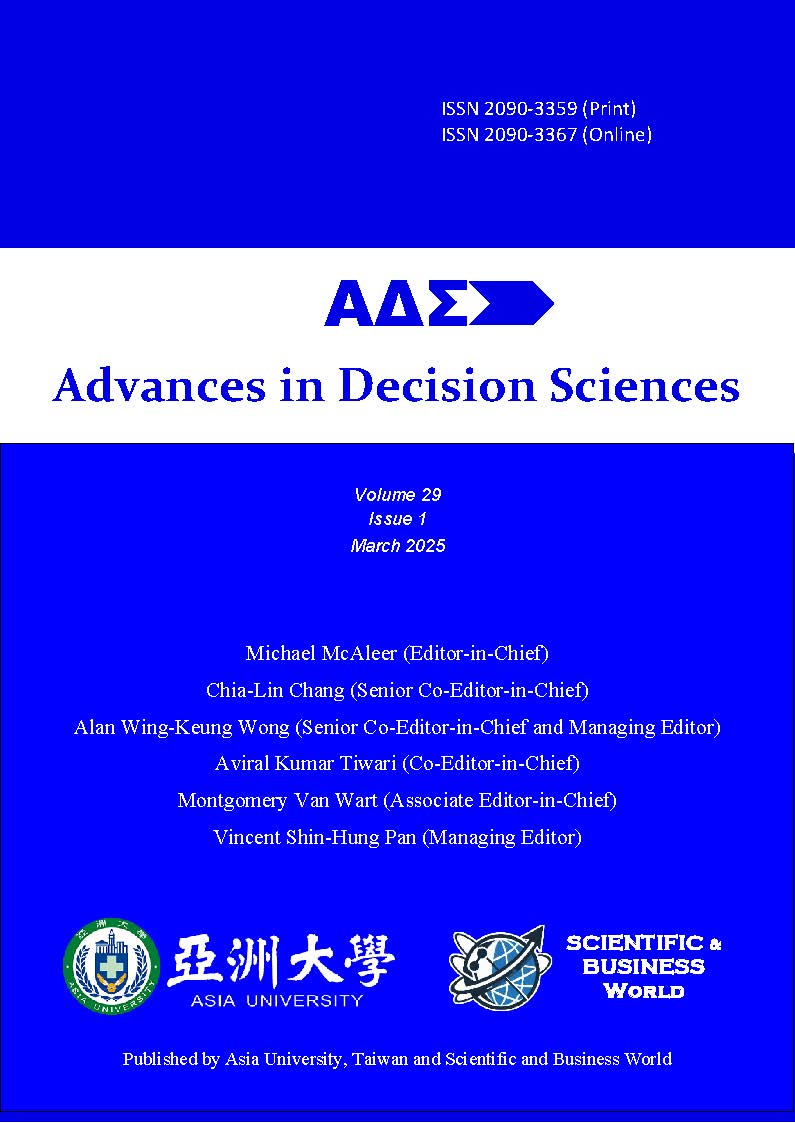Hedging Global Stock Markets with Bitcoin, Precious Metals, Copper, Crude Oil, and Agricultural Commodities: Evidence from Bivariate Threshold GARCH Approach
DOI:
https://doi.org/10.47654/v29y2025i1p35-54Keywords:
hedge ratio, hedging effectiveness, BEKK-GARCHAbstract
Purpose: This study examines the effectiveness of hedging global stock markets with hedge assets, including bitcoin, precious metals, copper, crude oil, and agricultural commodities. To achieve this, we selected eleven global stock market indices, including ASX 200, MSCI US, MSCI Europe, MSCI Japan, HSI, IBOVESPA, BSESN, SSECI, STI, TAIEX, and TSXCI to evaluate the effectiveness of hedging with the aforementioned hedge assets. Consequently, our current study offers a more up-to-date and comprehensive comparison of hedging effectiveness among multiple classes of hedge assets than earlier academic work.
Study design/methodology/approach: We collected weekly price data, denominated in USD, from Eikon (https://eikon.refinitiv.com/), covering the period from May 1, 2018, to March 2, 2023. For the analysis, this study utilized the bivariate diagonal BEKK-TGARCH and OLS models to estimate time-varying and static hedge ratios, respectively, with the goal of measuring the effectiveness of hedging.
Findings: In the empirical analysis of the BEKK-TGARCH model, we find that the return spillover effects are weak, and past information shocks influence the current variance-covariances of returns on most hedge assets but not on stock market returns. Moreover, the stock markets exhibit a stronger asymmetric leverage effect than the hedge assets. Furthermore, the BEKK-TGARCH model demonstrates greater hedging effectiveness than the OLS. Silver, copper, and crude oil emerge as highly effective hedge assets, whereas agricultural commodities are the least effective. Finally, ASX 200 and TSXCI are the most effectively hedged stock markets.
Practical Implications: This study evaluates the effectiveness of various hedge assets for hedging global stock markets and identifies the most effective hedge assets. Thus, our research is connected to the field of decision sciences, providing insights into hedging processes and optimal strategies for portfolio managers and hedgers.
References
Adekoya, O. B., Oliyide, J. A., Olubiyi, E. A., & Adedeji, A. O. (2023). The inflation-hedging performance of industrial metals in the world's most industrialized countries. Resources Policy, 81, 103364.
Adekoya, O. B., Oliyide, J. A., & Tahir, H. (2021). What do we know about the inflation-hedging property of precious metals in Africa? The case of leading producers of the commodities. Resources Policy, 72, 102120.
Ali, R., Mangla, I. U., Rehman, R. U., Xue, W., Naseem, M. A., & Ahmad, M. I. (2020). Exchange rate, gold price, and stock market nexus: A quantile regression approach. Risks, 8(3), 86.
Arenas-Falótico, A. J., & Scudiero, E. (2023). Futures contracts are a means of hedging market risks. AiBi Revista de Investigación, Administración e Ingeniería, 11(3), 42-51.
Baillie, R. T., & Myers, R. J. (1991). Bivariate GARCH estimation of the optimal commodity futures hedge. Journal of Applied Econometrics, 6(2), pp.109-124.
Batten, J. A., Kinateder, H., Szilagyi, P. G., & Wagner, N. F. (2021). Hedging stocks with oil. Energy Economics, 93, 104422.
Baur, D. G., Hoang, L. T., & Hossain, M. Z. (2022). Is Bitcoin a hedge? How extreme volatility can destroy the hedge property. Finance Research Letters, 47, 102655.
Beckmann, J., Czudaj, R. L., & Arora, V. (2020). The relationship between oil prices and exchange rates: Revisiting theory and evidence. Energy Economics, 88, 104772.
Boubaker, H., & Larbi, O. B. (2022). Dynamic dependence and hedging strategies in BRICS stock markets with oil during crises. Economic Analysis and Policy, 76, 263-279.
Bunditsakulporn, K. (2022). The Relationship between Agricultural Commodities and Stock Market in Case of Thailand: Safe-haven, hedge, or diversifier? –Cross Quantilogram Analysis. International Journal of Business & Administrative Studies, 8(3), 127-152.
Caporin, M., & McAleer, M. (2013). Ten things you should know about the dynamic conditional correlation representation. Econometrics, 1(1), 115-126.
Chang, C. L., McAleer, M., & Wong, W. K. (2018). Decision sciences, economics, finance, business, computing, and big data: Connections. Advances in Decision Sciences, 22(1), 36-94.
Chen, J. (2023). Copper futures hedging based on Markov switching approach. International Journal of Industrial and Systems Engineering, 44(3), 316-335.
Chiang, T. C. (2022). Can gold or silver be used as a hedge against policy uncertainty and COVID-19 in the Chinese market?. China Finance Review International, 12(4), 571-600.
Corbet, S., Larkin, C., & Lucey, B. (2020). The contagion effects of the COVID-19 pandemic: Evidence from gold and cryptocurrencies. Finance Research Letters, 35, 101554.
Coronado, S., Gupta, R., Hkiri, B., & Rojas, O. (2020). Time-varying spillovers between currency and stock markets in the USA: Historical evidence from more than two centuries. Advances in Decision Sciences, 24(4), 1-32.
Dibooglu, S., Cevik, E. I., & Gillman, M. (2022). Gold, silver, and the US dollar as harbingers of financial calm and distress. The Quarterly Review of Economics and Finance, 86, 200-210.
Dyhrberg, A. H. (2016). Hedging capabilities of bitcoin. Is it the virtual gold?. Finance Research Letters, 16, 139-144.
Engle, R. (2002). Dynamic conditional correlation: A simple class of multivariate generalized autoregressive conditional heteroskedasticity models. Journal of Business & Economic Statistics, 20(3), 339-350.
Engle, R. F., & Kroner, K. F. (1995). Multivariate simultaneous generalized ARCH. Econometric Theory, 11(1), 122-150.
Fang, F., Ventre, C., Basios, M., Kanthan, L., Martinez-Rego, D., Wu, F., & Li, L. (2022). Cryptocurrency trading: a comprehensive survey. Financial Innovation, 8(1), 13.
Feng, H., Zhang, J., & Guo, N. (2023). Time-varying linkages between energy and stock markets: Dynamic spillovers and driving factors. International Review of Financial Analysis, 89, 102714.
Foroni, C., Guérin, P., & Marcellino, M. (2017). Explaining the time-varying effects of oil market shocks on US stock returns. Economics letters, 155, 84-88.
Gunera, J. E. B. (2023). Cycles and Dynamic Correlations Between Agricultural and Stock Markets (Master's thesis, Louisiana State University and Agricultural & Mechanical College).
Haliplii, R. (2020). Hedging in alternative markets (Doctoral dissertation, Université Panthéon-Sorbonne-Paris I).
Hanif, W., Mensi, W., Vo, X. V., BenSaïda, A., Hernandez, J. A., & Kang, S. H. (2023). Dependence and risk management of portfolios of metals and agricultural commodity futures. Resources Policy, 82, 103567.
Hasan-Zadeh, A. (2019). Mathematical modelling of decision-making: Application to investment. Advances in Decision Sciences, 23(2), 1-14.
Hernandez, J. A., Kang, S. H., & Yoon, S. M. (2021). Spillovers and portfolio optimization of agricultural commodity and global equity markets. Applied Economics, 53(12), 1326-1341.
Ji, H., Wang, H., Zhong, R., & Li, M. (2020). China's liberalizing stock market, crude oil, and safe-haven assets: A linkage study based on a novel multivariate wavelet-vine copula approach. Economic Modelling, 93, 187-204.
Kangalli Uyar, S. G., Uyar, U., & Balkan, E. (2022). The role of precious metals in extreme market conditions: evidence from stock markets. Studies in Economics and Finance, 39(1), 63-78.
Kliber, A., Marszałek, P., Musiałkowska, I., & Świerczyńska, K. (2019). Bitcoin: Safe haven, hedge or diversifier? Perception of bitcoin in the context of a country’s economic situation—A stochastic volatility approach. Physica A: Statistical Mechanics and Its Applications, 524, 246-257.
Ku, Y. H. H., Chen, H. C., & Chen, K. H. (2007). On the application of the dynamic conditional correlation model in estimating optimal time-varying hedge ratios. Applied Economics Letters, 14(7), 503-509.
Lien, D., & Tse, Y. K. (2002). Some recent developments in futures hedging. Journal of Economic Surveys, 16(3), 357-396.
Liu, C., Naeem, M. A., Rehman, M. U., Farid, S., & Shahzad, S. J. H. (2020). Oil as hedge, safe-haven, and diversifier for conventional currencies. Energies, 13(17), 4354.
Liu, M., & Lee, C. C. (2022). Is gold a long-run hedge, diversifier, or safe haven for oil? Empirical evidence based on DCC-MIDAS. Resources Policy, 76, 102703.
Mensi, W., Aslan, A., Vo, X. V., & Kang, S. H. (2023). Time-frequency spillovers and connectedness between precious metals, oil futures and financial markets: Hedge and safe haven implications. International Review of Economics & Finance, 83, 219-232.
Mikhaylov, A. (2020). Cryptocurrency market analysis from the open innovation perspective. Journal of Open Innovation: Technology, Market, and Complexity, 6(4), 197.
Ming, L., Yang, P., Tian, X., Yang, S., & Dong, M. (2023). Safe haven for crude oil: Gold or currencies? Finance Research Letters, 54, 103793.
Naeem, M. A., Agyemang, A., Chowdhury, M. I. H., Hasan, M., & Shahzad, S. J. H. (2022). Precious metals as hedge and safe haven for African stock markets. Resources Policy, 78, 102781.
Okorie, D. I. (2020). Could stock hedge Bitcoin risk (s) and vice versa?. Digital Finance, 2(1), 117-136.
Olstad, A., Filis, G., & Degiannakis, S. (2021). Oil and currency volatilities: Co‐movements and hedging opportunities. International Journal of Finance & Economics, 26(2), 2351-2374.
Ourir, A., Bouri, E., & Essaadi, E. (2023). Hedging the risks of MENA stock markets with gold: Evidence from the spectral approach. Computational Economics, 61(1), 197-231.
Paul, M., Bhanja, N., & Dar, A. B. (2023). On the similarities between precious metals, precious metal stocks and equities–International evidence for gold and silver. Resources Policy, 83, 103629.
Rizvi, S. K. A., Naqvi, B., Mirza, N., & Umar, M. (2022). Safe haven properties of green, Islamic, and crypto assets and investor's proclivity towards treasury and gold. Energy Economics, 115, 106396.
Salisu, A. A., Ndako, U. B., & Oloko, T. F. (2019). Assessing the inflation hedging of gold and palladium in OECD countries. Resources Policy, 62, 357-377.
Shahzad, S. J. H., Bouri, E., Rehman, M. U., Naeem, M. A., & Saeed, T. (2022). Oil price risk exposure of BRIC stock markets and hedging effectiveness. Annals of Operations Research, 1-26.
Spencer, S., Bredin, D., & Conlon, T. (2018). Energy and agricultural commodities revealed through hedging characteristics: Evidence from developing and mature markets. Journal of Commodity Markets, 9, 1-20.
Tuan, B. A., Luu, T. Q., Pan, S. H., & Wong, W. K. (2022). Wilson models and its applications in decision sciences. Advances in Decision Sciences, 26(5), 15-39.
Valadkhani, A., Nguyen, J., & Chiah, M. (2022). When is gold an effective hedge against inflation?. Resources Policy, 79, 103009.
Wong, W. S., Saerbeck, D., & Delgado Silva, D. (2018). Cryptocurrency: A new investment opportunity? An investigation of the hedging capability of cryptocurrencies and their influence on stock, bond and gold portfolios (January 29, 2018). Available at SSRN: https://ssrn.com/abstract=3125737.
Woo, K. Y. & Zheng, Z. (2025). Hedging global stock markets with bitcoin, precious metals, copper, crude oil and agricultural commodities: Evidence from multivariate asymmetric GARCH approach, Working Paper, Hong Kong Shue Yan University. Available at: http://hdl.handle.net/20.500.11861/10707
Xu, L., & Kinkyo, T. (2023). Hedging effectiveness of bitcoin and gold: Evidence from G7 stock markets. Journal of International Financial Markets, Institutions and Money, 85, 101764.
Xu, S., Du, Z., & Zhang, H. (2020). Can crude oil serve as a hedging asset for underlying securities? — research on the heterogenous correlation between crude oil and stock index. Energies, 13(12), 3139.
Yu, X., Li, Y., Lu, J., & Shen, X. (2023). Futures hedging in crude oil markets: A trade-off between risk and return. Resources Policy, 80, 103147.

Published
Issue
Section
Categories
License
Copyright (c) 2025 Advances in Decision Sciences

This work is licensed under a Creative Commons Attribution-NonCommercial 4.0 International License.



 Scientific and Business World
Scientific and Business World